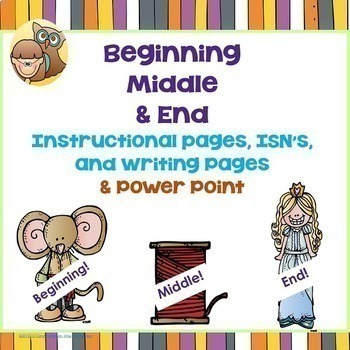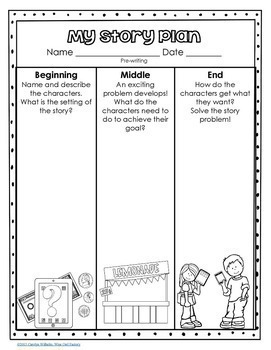Beginning, Middle, and End Story Writing Lesson 250 pages K-2
- Google Slides™
- Easel Assessment

What educators are saying
Description
Beginning, Middle, and End Story Writing Lesson 250 pages
Very little preparation, just print and go!
This is a completely animated PowerPoint, in view slide show mode. Just keep clicking to see sequences numbered automatically. The PDFs are included in the zip folder. Students and teachers may move the numbers and sequenced activities in the normal mode.
All versions of this product have two sets of Google Slides for students. There are two instructional presentations on Google Slides.
Interactive Student Notebook pages included
Kindergarten section included
Beginning, Middle, and End of story writing is something that emergent writers need to practice. (See Common Core standards, below) This PowerPoint reviews the beginning, middle, and end of some familiar stories. Sequencing of sentences is also covered. Students practice drawing a story using a graphic organizer for the three parts of beginning, middle, and end of their own story. Then, finally, students write their stories from the graphic organizer on three stapled pages with the beginning on page one, the middle part of the story on page two, and the ending on page three. The three-part drawing may be referred to as students think about which part of the story belongs on each page. Teachers and peer editors could say, "Tell me about your drawings." Telling about the drawing often prompts students to know what to write.
There are several beginning-middle-end work pages to choose from to differentiate this assignment. After students are successful with one, others could be offered. Included are open-ended "chapter books" for students to write.
See free printable ISN in the preview PDF of this listing. Check the Wise Owl Factory blog for more information about this product, and another sample.
English Language Arts Standards, Writing, Grade 1
Text Types and Purposes
1. Write narratives in which they recount two or more appropriately sequenced events, include some details regarding what happened, use temporal words to signal event order, and provide some sense of closure.
COMMON CORE STANDARDS:
English Language Arts Standards, Reading: Literature, Grade 2
Craft and Structure
1.Describe the overall structure of a story, including describing how the beginning introduces the story and the ending concludes the action.
English Language Arts Standards, Writing, Grade 2
Text Types and Purposes
1.Write narratives in which they recount a well-elaborated event or short sequence of events, include details to describe actions, thoughts, and feelings, use temporal words to signal event order, and provide a sense of closure.
Graphics licensed through the Graphics Factory.
Carolyn Wilhelm, NBCT
Wise Owl Factory






